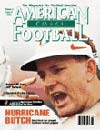AMERICAN FOOTBALL MONTHLY THE #1 RESOURCE FOR FOOTBALL COACHES
Article CategoriesAFM Magazine
|
The Turner NetworkTwo Brothers, Two Teams, and one direction. . . up.by: Michael Richman © More from this issue Both head coaches had their backs to the wall entering the season, Norv with the Washington Redskins and Ron at the University of Illinois. Norv had gone five seasons without reaching the playoffs, the longest stretch of any active NFL coach, and Ron had crafted a 3-19 record in his first two years. New Redskins owner Daniel Snyder applied volumes of extra pressure on Norv by telling him to make the playoffs or find a new job. Ron was in the critical third year of a five-year contract. Talk about adversity. Then talk about responding to it. Norv coached the Redskins to a 10-6 record, the NFC East title and the second round of the playoffs, where they lost to Tampa Bay by one point. Ron's Fighting Illini posted a 7-4 mark and crushed Virginia in the MicronPC.com Bowl, 63-21. Both Turners dismiss the irony of the season.....The full article can only be seen by subscribers.
|
|
|||||||
| HOME |
MAGAZINE |
SUBSCRIBE | ONLINE COLUMNISTS | COACHING VIDEOS |
Copyright 2025, AmericanFootballMonthly.com
All Rights Reserved





